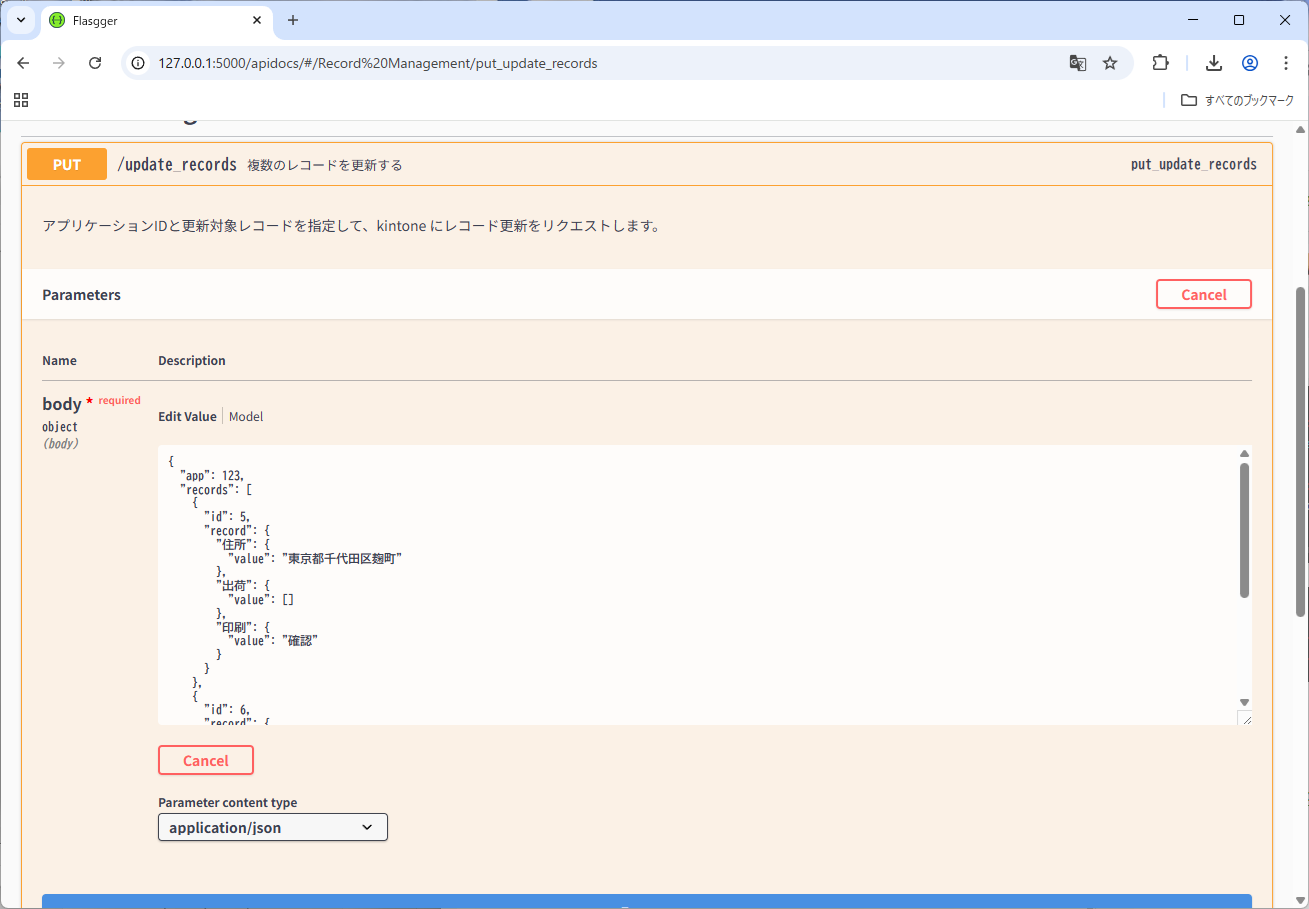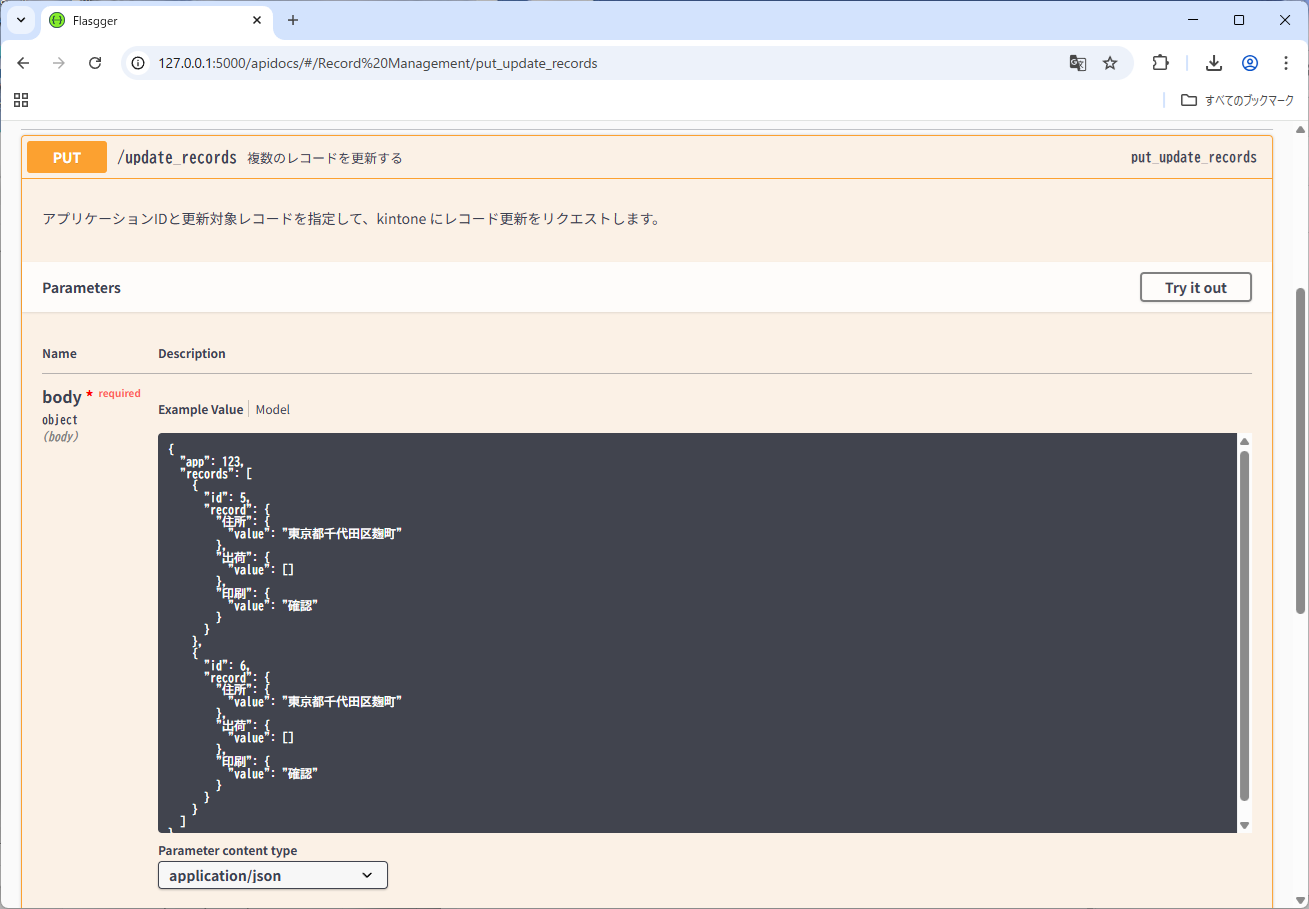下記の記事で、編集不可にしたフィールド値を変更する Python プログラムを作成しましたが、今回はそのプログラムにユーザーインターフェース(Python Flask、OpenAPI(Swagger))を追加したバージョンです。
flasgger 用のコメントを自分で書くことは難しく、ChatGPT を活用しました。
pip install flask flasgger
100_update_records.py
from flask import Flask, jsonify, request
from flasgger import Swagger
import base64
import urllib.request
import json
import os
import sys
from pathlib import Path
app = Flask(__name__)
app.json.ensure_ascii = False
swagger = Swagger(app)
kintone_api_key = os.environ.get("KINTONE_API_KEY")
if not kintone_api_key:
print("Error: KINTONE_API_KEY must be set in environment variables")
sys.exit(1)
@app.route("/")
def index():
return " Python の Web サーバーです!"
@app.route('/update_records', methods=['PUT'])
def update_records():
"""
複数のレコードを更新する
---
tags:
- Record Management
description: アプリケーションIDと更新対象レコードを指定して、kintone にレコード更新をリクエストします。
parameters:
- in: body
name: body
required: true
schema:
type: object
required:
- app
- records
properties:
app:
type: integer
description: アプリID
example: 123
records:
type: array
description: 更新するレコードの情報
items:
type: object
properties:
id:
type: integer
description: レコードID
example: 12
record:
type: object
description: レコード(フィールドコードとフィールドの値)を指定したオブジェクト
example:
印刷:
value: "確認"
出荷:
value: [ ]
住所:
value: "東京都千代田区麹町"
example:
- id: 5
record:
印刷:
value: "確認"
出荷:
value: [ ]
住所:
value: "東京都千代田区麹町"
- id: 6
record:
印刷:
value: "確認"
出荷:
value: [ ]
住所:
value: "東京都千代田区麹町"
responses:
200:
description: 正常に更新された場合
schema:
type: object
properties:
records:
type: array
description: 更新したレコードのIDとリビジョン番号のオブジェクトの配列
items:
type: object
properties:
id:
type: integer
description: 更新したレコードのレコードID
example: 12
revision:
type: integer
description: 更新したレコードのリビジョン番号
example: 45
example:
- id: "5"
revision: "11"
- id: "6"
revision: "11"
500:
description: サーバーエラー
schema:
type: object
properties:
error_code:
type: integer
example: 5000
error_msg:
type: string
example: "Internal Server Error"
"""
try:
data = request.get_json()
app_id = data.get("app", 1001)
records = data.get("records", {})
uri = "https://sample.cybozu.com/k/v1/records.json"
binary_bytes = base64.b64decode(kintone_api_key)
binary_string = binary_bytes.decode('latin1')
headers = {
"X-Cybozu-API-Token": binary_string,
"Content-Type": "application/json",
}
body = {
"app": app_id,
"records": records
}
req = urllib.request.Request(
url=uri,
data=json.dumps(body).encode(),
headers=headers,
method="PUT",
)
response = urllib.request.urlopen(req)
res_dict = json.load(response)
return jsonify(res_dict)
except Exception as e:
return jsonify({"error_code": 5000, "error_msg": str(e)}), 500
if __name__ == "__main__":
app.run(debug=True, port=5000)
実行
# アプリIDに対する Kintone の API Key を設定します
export KINTONE_API_KEY="..."
python 100_update_records.py
画面
http://127.0.0.1:5000/apidocs/
「Try it out」ボタンを押下します。送信パラメータが編集可能になるので、アプリID(app)、レコードID(id)、フィールドコード、値(value)を指定して、「Execute」ボタンを押下します。

他の事例ですが、結果は次のようになります。

ユーザー名/パスワード版
101_update_records.py
from flask import Flask, jsonify, request
from flasgger import Swagger
import base64
import urllib.request
import json
import os
import sys
from pathlib import Path
app = Flask(__name__)
app.json.ensure_ascii = False
swagger = Swagger(app)
kintone_username = os.environ.get("KINTONE_USERNAME")
if not kintone_username:
print("Error: KINTONE_USERNAME must be set in environment variables")
sys.exit(1)
kintone_password = os.environ.get("KINTONE_PASSWORD")
if not kintone_password:
print("Error: KINTONE_PASSWORD must be set in environment variables")
sys.exit(1)
@app.route("/")
def index():
return " Python の Web サーバーです!"
@app.route('/update_records', methods=['PUT'])
def update_records():
"""
複数のレコードを更新する
---
tags:
- Record Management
description: アプリケーションIDと更新対象レコードを指定して、kintone にレコード更新をリクエストします。
parameters:
- in: body
name: body
required: true
schema:
type: object
required:
- app
- records
properties:
app:
type: integer
description: アプリID
example: 123
records:
type: array
description: 更新するレコードの情報
items:
type: object
properties:
id:
type: integer
description: レコードID
example: 12
record:
type: object
description: レコード(フィールドコードとフィールドの値)を指定したオブジェクト
example:
印刷:
value: "確認"
出荷:
value: [ ]
住所:
value: "東京都千代田区麹町"
example:
- id: 5
record:
印刷:
value: "確認"
出荷:
value: [ ]
住所:
value: "東京都千代田区麹町"
- id: 6
record:
印刷:
value: "確認"
出荷:
value: [ ]
住所:
value: "東京都千代田区麹町"
responses:
200:
description: 正常に更新された場合
schema:
type: object
properties:
records:
type: array
description: 更新したレコードのIDとリビジョン番号のオブジェクトの配列
items:
type: object
properties:
id:
type: integer
description: 更新したレコードのレコードID
example: 12
revision:
type: integer
description: 更新したレコードのリビジョン番号
example: 45
example:
- id: "5"
revision: "11"
- id: "6"
revision: "11"
500:
description: サーバーエラー
schema:
type: object
properties:
error_code:
type: integer
example: 5000
error_msg:
type: string
example: "Internal Server Error"
"""
try:
data = request.get_json()
app_id = data.get("app", 1001)
records = data.get("records", {})
uri = "https://sample.cybozu.com/k/v1/records.json"
username_password = f"{kintone_username}:{kintone_password}"
auth_header = base64.b64encode(username_password.encode())
headers = {
"Host": "sample.cybozu.com:443",
"X-Cybozu-Authorization": auth_header,
"Content-Type": "application/json",
}
body = {
"app": app_id,
"records": records
}
req = urllib.request.Request(
url=uri,
data=json.dumps(body).encode(),
headers=headers,
method="PUT",
)
response = urllib.request.urlopen(req)
res_dict = json.load(response)
return jsonify(res_dict)
except Exception as e:
return jsonify({"error_code": 5000, "error_msg": str(e)}), 500
if __name__ == "__main__":
app.run(debug=True, port=5000)
実行
# Kintone のユーザー名とパスワードを設定します
export KINTONE_USERNAME="..."
export KINTONE_PASSWORDE="..."
python 101_update_records.py
画面表示
http://127.0.0.1:5000/apidocs/
参考ページ
以下のウェブページも見つけましたが、難しい

